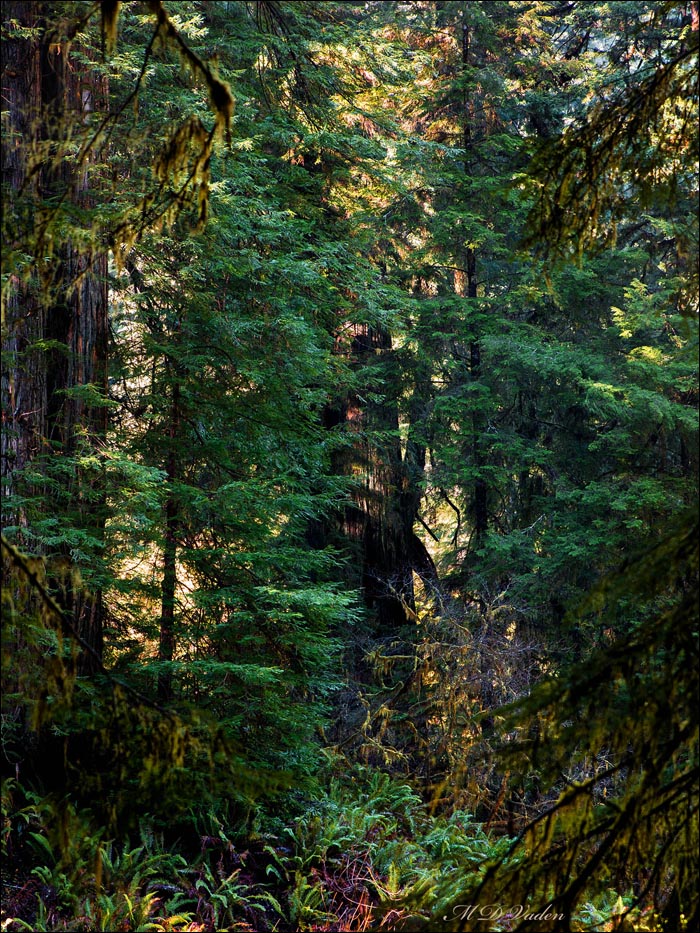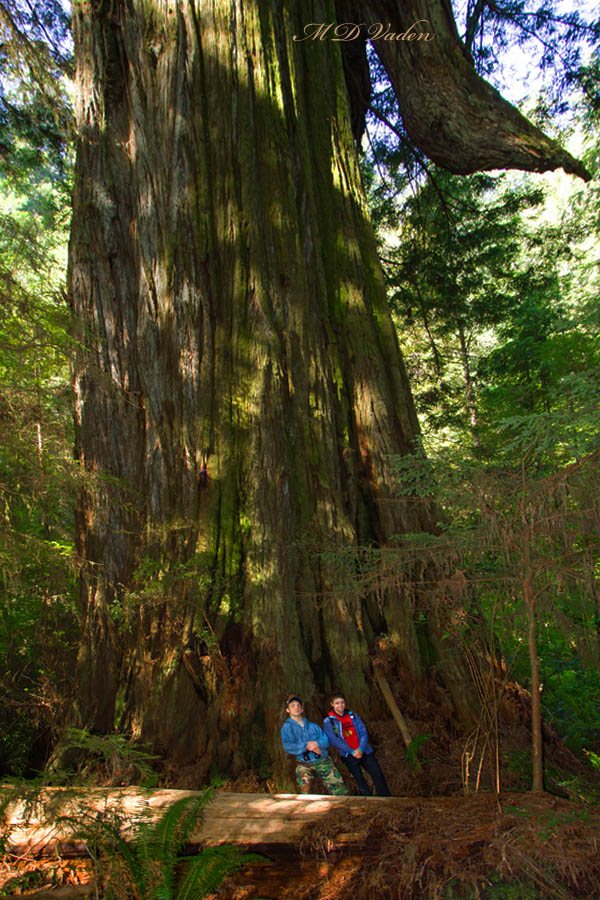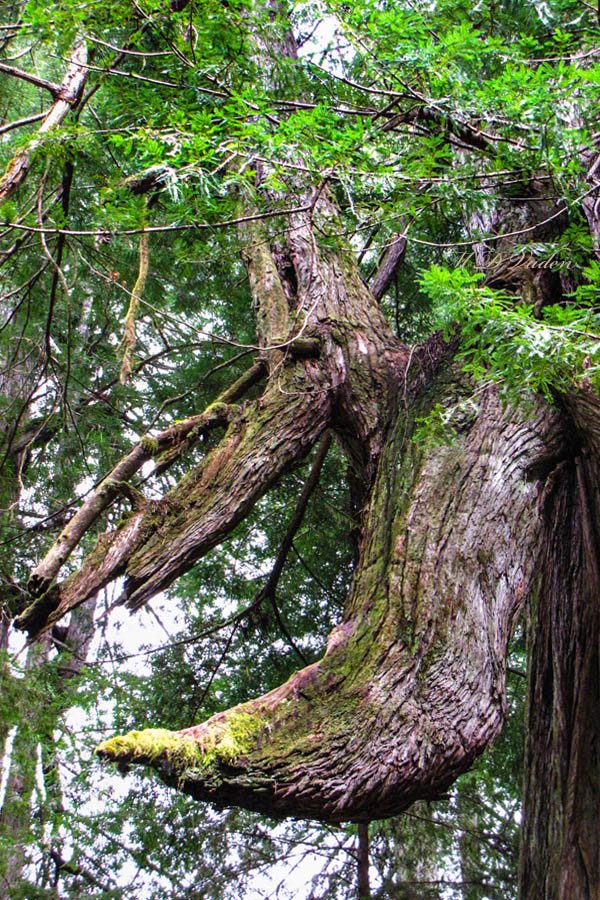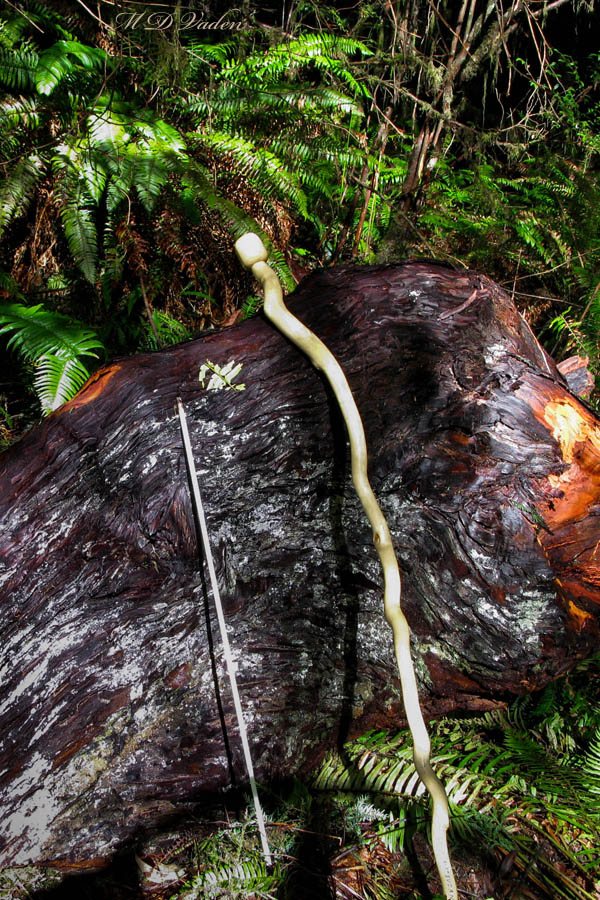
El Viejo del Norte Redwood .. Old Man of the North .. #9
by Mario Vaden
El Viejo del Norte is one of the Grove of Titans redwoods discovered May 11, 1998, by Michael Taylor and Dr. Steve Sillett. It was the second redwood titan seen on "The day of Discovery" after the men approached Screaming Titans in the midst of Jedediah Smith Redwoods. The grove is in the forest across from the campground and Smith River along and very close to Mill Creek. The heading 5th largest dates back to 2009. After 2014 and other more recent discoveries, El Viejo became more like 6th, 7th, 8th, etc.. Robert Van Pelt wrote in 2001 that El Viejo had 1177 American Forests points.

advertisement
The 2009 measurements were 323.8 feet tall .. 23 feet diameter dbh .. 35,400 cu. ft.
The photo below was taken January 2017. The shot was taken from south looking north, from the opposite side of Mill Creek. This view is more concealed in summer when the vine maple stems hold leaves. The trunk is slightly more narrow than Lost Monarch, and because El Viejo is farther from flowing surface water, I suspect it may be the oldest redwood in the grove and grew slower.
Read more following this image ...

El Viejo del Norte was climbed by researchers who found fern mats including one of the largest known measuring 25 feet long, six feet wide and 3 feet thick. Almost like a forest floor above the forest floor 260' up in the canopy. Growing on the fern mat were evergreen huckleberry and leatherleaf fern, Polypodium scouleri.
One of the most unique things about this redwood is a network of limbs and stems which have grown broken, fused, re-oriented by bending .. then again .. broken, fused, etc.. The damage, growth and change to limbs in the lower crown is believed to be associated with an old landslide, stream that shifted course and triggered some chaos. But this redwood is so old, just time, growth and breakage alone could cause the type of wood shapes seen. In other words, it's been battered by nature and other trees for centuries.

Quite a few people call the gnarly shapes "burls" but that is incorrect. Most of the unusual and unique shapes are associated with limb and stem growth that experienced many phases of growth and breakage.
One in particular reminds me of a huge elephant tusk or rhinocerous horn.

Another large redwood in the grove, Lost Monarch, is nearby. Both redwoods' roots are in reach of moist marshy soil adjacent to them, but Lost Monarch is closest to the water. The main trunk form of El Viejo del Norte is very similar to that of Lost Monarch except slightly smaller proportionately. El Viejo del Norte had a significant dead top when first discovered.
From what I understand, El Viejo del Norte may be in a slight state of decline. At least from one researcher's point of view. But the time-table for redwood decline may be centuries compared to the various species in urban areas that perish in mere decades. This "Old Man of the North" (so its name means) could be around for a long time provided wind doesn't blow it over soon.
Natural propagation & cloning
A big chunk broke off and fell during the winter of 2007 - 2008. A few tons worth of wood, canopy soil and ferns. The image below shows a small fraction - that's my walking stick next to it. The big piece was interesting to observe for a couple of years. I was checking to see if it would survive as a natural clone redwood because the wood sprouted stems and foliage that spring and summer of 2008. This part of the redwood resting on the ground remained alive for over one year and the stems grew even more the following spring and summer. Finally by autumn 2009, the stems and foliage on the fallen piece finally dried up.
It's possible for pieces of redwood to root into earth. But this time roots did not manage to grow from wood into the earth to produce self-propagation and another redwood. Even though this chunk didn't grow roots to the earth and survive past two years, certainly other pieces falling from other redwoods elsewhere do survive occassionally.
Natural propagation terminated by human activity - seeds / clones / cathedrals
Have you read my page for Screaming Titans? I learned that human activity triggered by someone leaking these redwood locations erased any chance that any fallen piece or seed will ever grow and survive. Careless visitors trampled vegetation, climbed up trunks and pulverized new redwood sprouts. Redwood titans with lots of traffic will never become a cathedral redwood. No coast redwood seeds will ever germinate and survive around if boots trample germinated growth. No falllen piece of canopy will ever survive to become another natural clone.
That is the result of human-triggered leaks and traffic. Nature can no longer regenerate itself in these areas. It's not like the old days when just a few responsible people visited without crushing ferns or redwood sorrel.
Miscelleneous artifacts
There is also one artifact in the photo. A rubber tipped arrow from a researcher's crossbow. This is astray that richocheted out of sight during the grove research project. These arrows are used to feed small lines up into redwoods to help pull climbing lines in place to access the canopy. The arrrow was launched by a crossbow with a fishing reel and line retrofitted.
